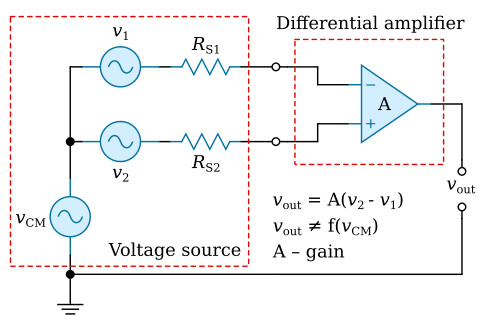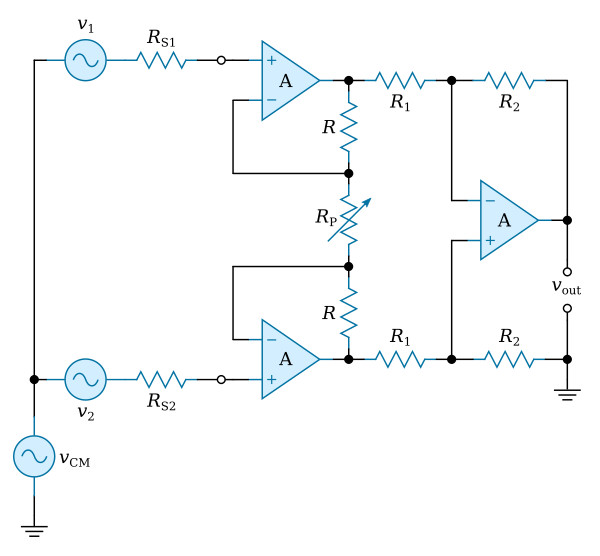Home > Textbooks > Basic Electronics > Operational Amplifiers > Differential Amplifier >
Operational Amplifiers
Differential Amplifier
The ideal differential amplifier amplifies only the difference between two input signals (see below). This type of amplifier is useful for amplifying signals from various transducers and for rejecting common-mode noise signals. As can be seen the figure below, the output voltage vout is a function of the difference between the two input voltages, v1 and v2. The amplifier input marked with a negative sign is called the inverting input. The amplifier input marked by a positive sign is called the non-inverting input. If one of the inputs is grounded (that is, v1 or v2 is zero) then the amplifier is a simple non-differential inverting (v2 grounded) or non-inverting (v1 grounded) amplifier. The principal advantage of a differential amplifier is its ability to reject common-mode signal (vCM in the figure below). In an ideal differential amplifier, the output is not affected by common-mode voltage, i.e. vout ≠ f(vCM).

A differential-amplifier circuit constructed from a single operational amplifier is shown below.

If the source resistances RS1 and RS2 are much lower than R1, the output voltage is

Ideally, the amplifier is completely insensitive to the common-mode voltage vCM. In actual practice, R2 and R1 have to be very carefully matched to provide good common-mode rejection even when the source resistance RS1 and RS2 are zero. For real values of RS1 and RS2, where RS1 exactly equals RS2, the common-mode rejection ratio is unaffected but the gain changes, as shown in

Instrumentation Amplifier
Most of the limitations of the above differential amplifier can be eliminated by placing two non-inverting operational amplifiers in the inputs as shown below. This is a typical instrumentation amplifier.

The differential amplifier qualifies as a general-purpose instrumentation amplifier when it possesses the following: high input impedance; high common-mode voltage rejection; stable but easily variable voltage gain; low output impedance; adequate frequency bandwidth; and appropriate output drive capability. Integrated-circuit technology combined with the demand for large numbers of these types of amplifiers has made them available in flat packages which are ideally suited for voltage amplification purposes.
In this amplifier circuit (see the figure above), Rp is a variable resistor which provides an easy (and very nonlinear) gain adjustment. The input impedance is very high, which minimizes the effects of imbalances in RS1 and RS2. A mismatch between the two resistors labeled R produces a gain error without affecting the common-mode rejection of the circuit. For convenience, R1 and R2 are often made equal, because they must be very closely matched to achieve excellent common-mode voltage rejection. In this case, the final stage performs simply as a differential-input to single-ended output amplifier. Feedback resistors in all stages can be kept low to reduce the output-voltage offset caused by the various input bias currents. When most of the amplifier gain is in the first stage, the input offset voltages of these two input operational amplifiers determine the output-voltage offset. When the input voltage offsets of each input amplifier are equal and track one another, then the differential second stage cancels most of the input-voltage offset effects, including drift. The input bias currents associated with the non-inverting inputs of the first stage flow through RS1 and RS2, and a mismatch between RS1 and RS2 or the two input bias currents will cause an output offset error.
The output voltage of the instrumentation amplifier is

Normally, it is more economical to use mass-produced integrated-circuit instrumentation amplifiers than to construct them; however, specialized requirements may dictate the use of a custom-built instrumentation amplifier.






